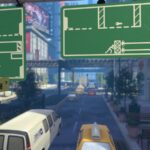When I was younger and my dad was playing a game, there was something he would say ceaselessly, seemingly irrespective of the game, and that was “look at the graphics!”. It’s understandable that someone coming from a childhood of Amiga and Sinclair would have this reaction to anything with any sort of detail, and playing The Pedestrian had me thinking the same thing. My partner listened to me repeat over and over again platitudes dedicated to the minute details found in every inch of The Pedestrian: The glimmering beans in a burrito, the unpredictable cracks in concrete, the worn shoes swinging naturally across a phone line. It might stem from a similar place as my dad’s complete awe too. The game’s he played as a kid were developed by bedroom coders, teams of one, two if you were lucky, and here’s The Pedestrian, a game with such beauty you’d think only possible with the most advanced technology, supported by the might of an army of developers, actually crafted by a small team of four.
The pedestrian crossing sign comes in many forms, and yet the void black human blob found on all of them is instantly recognisable as an icon of direction. We take control of one of them, unchained and unburdened by their daily static routines, setting out on a journey across a highly detailed city, through the mucky gutters and tatty constructions sites, through the affluent city streets and pristine college campus’, on a 2D plane, mind, latching to the signs we see all around us.
The Pedestrian is ostensibly a puzzle game through and through, one, as I say, played on flat surfaces, a fact which mostly explains how gobsmacked I was to see how fully realised the “rest” of the world is. This same game could’ve worked, perhaps developed in a shorter span than the 7 years it took Skookum Arts here, entirely without the immensely detailed world surrounding the puzzles. Right from the offset, The Pedestrian is proving it’s anything but: pipes and brick walls coated in scratches and cracks, the aforementioned kidney beans sheening discretely inside their flour housing, vines creeping their way up iron bars, proudly flourishing their lushious tendrils and leaves, even the way the undetectable objects behind the camera leave distinct shadows on the background in front of our eyes. The Pedestrian, not only in the confines of an indie game with a small development team, is a visual marvel, one developed in an engine (Unity) perpetually ridiculed for abetting the development of amateurish, sloppy first attempts of video games. A first attempt it is, but The Pedestrian is as far from sloppy as one could come.
It might come as a slight to comment on it second, then, but it’s very much not intended, as the soundtrack accompanying the game is full of personality and range. In the opening few acts, you’d be mistaken for thinking they’d ripped the very essence from a golden-era Pixar film, with swooning notes reaching the peak of human hearing, dive bombing into the twinkling of fairies, sharply cutting out and slowly building again, evoking a sense of adventure only found in the whimsical soul of an animated childrens flick. Up and Ratatouille were specific titles that came to mind as the tunes bounced around my head, the latter alluded to further by the scenery of sparkling, isolated street lamps stuck in a swamp of dingy late night darkness. It’s varied, too, hopping from genre to theme like the soaring notes themselves, at times feeling jazzy and classy, other times mischievous and investigative. If there was any criticism to be had of the soundtrack, it would be it’s lack of a home. The diversity at play here, combined with the general fantastical element to it all, doesn’t quite nail the vibe of The Pedestrian, perhaps the game is lacking one to begin with, stuck between gorgeous visuals and delectable sounds, neither of which forging a single identity for the game to run with. Occasionally, particularly later in the game, the music will cut out eerily, not actually forecasting anything sinister, just…cutting out, which hurts, as it’s so damn good!

I don’t think it’s typical that reviews for puzzle games tend to discuss anything but the puzzles first, and the logical reaction would be to preempt the worst. The Pedestrian is thankfully a misnomer, incorporating the panel shifting gameplay of Framed with some electrical rewiring mechanics, a wholly unique experience that doesn’t quite reach the peaks of the presentation, but is far too engaging to consider poor. The game introduces our nameless, faceless protagonist of sorts, running from sign to sign which while literally disconnected in the reality of the world, we travel across them as if they were connected by invisible corridors. They are, somewhat, as we quickly learn to link panels as if they were wires on a circuit board, allowing us to travel between them freely. The comparison becomes more apt once mechanics like the wire get introduced, letting us bridge connecting inside the signs to essentially give certain things power. Oh, that’s worth pointing out, the game works on two levels as such. The 2D platforming element has us jumping around, using the wire item for example, while we can also press a button to zoom out and shift the signs themselves, creating those “invisible corridors. Later in the game, once items like the box and keys come into play, the game manages to strike a nice balance between the two perspectives, swapping in and out naturally and neither dominating the experience. On the topic of balance, The Pedestrian, excluding a couple of times in my playthrough, is paced rather well, knowing when to throw a hard puzzle at the player and when to let them breeze through a section and take in their surroundings. It quickly falls into a pattern of transition areas – light on actual puzzles and more so cathartic simple platforming – followed by hub areas where you solve a few challenging puzzles, which at times require you to just sit back and stare at the TV, trying to ignore the beauty in the background and think about how to solve the puzzle.

“Integration” seems to be the key word in relation to The Pedestrian, not only in a literal sense; integrating connections between the signs to progress. But the two worlds of the game, the monochromatic flat world and the palpable, “real” world blend together in a lovely way. At several times, what you do in the puzzle realm directly affects what’s happening in the background dimension, bridging a connection might open a gate, or solving a puzzle might lurch us forward on a train. It’s illustrated no better than in the final act, a seamless flourish which feels like a gameplay zenith and quickly establishes a short narrative finale, despite the game never quite building up to any form of plot beforehand. That is perhaps the game’s biggest shortcoming, not what it does wrong, just what it didn’t include. And it’s a hard one to critique, because on one hand, I love that The Pedestrian is this quaint little innovative puzzle game, one which will undoubtedly draw comparisons to the revered genre staple, The Witness, yet through its lack of a narrative, doesn’t feel as lofty. I like that about it, and yet I think it’s clear the developers are talented enough to make a fully fledged story out of this concept, and the final chapters teasing of one is bittersweet; an abrupt twist executed with poise, yet doesn’t actually amount to anything significant, no point to be made or moral to muse over.
I can’t remember if I’ve been this overt with this upcoming statement before, but I’ve been thinking it for a while: Xbox Game Pass is the best thing to happen in gaming in years. It’s easy to view it as a nothing more than a good bargain for those that don’t care if they own their games, and it absolutely is that, and yet at the same time exists as this almost indispensable tool for game discovery. Hand me the The Pedestrian’s Steam page and I’d probably think it looks real neat, swiftly wish listing it, destined for a life of neglect. But because of Game Pass, I played it. I don’t know the psychological reasons behind why, but there’s something about the system which encourages me to try whatever’s on there. Oh and I’m so glad I did, because The Pedestrian is a game which might not click with me on a purely gameplay level when you consider my broader tastes in puzzle games (if it ain’t Hexcells, I probably don’t care about it) but it just works, undeniably, indisputably works. Works well, too, and that’s disregarding the presentation element, a focus of the game which elevates it to a level other games could only dream of achieving.

